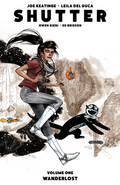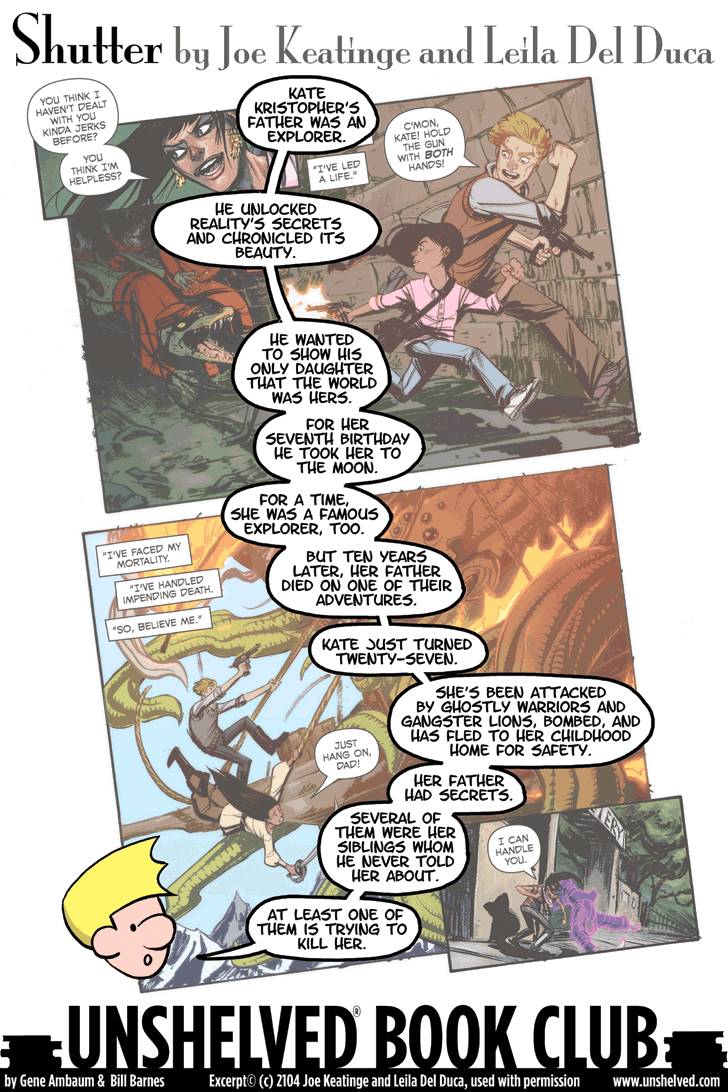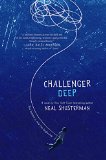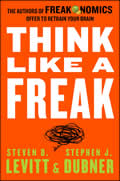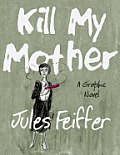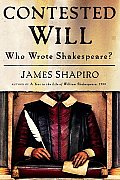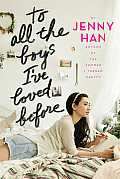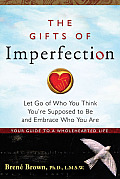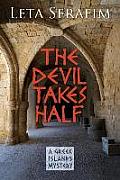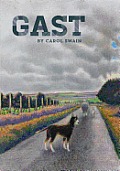Link to this review in the form of a comic strip by geneambaum tagged science fiction • coming of age
Link to this review by flemtastic tagged coming of age
Caden has very vivid hallucinations of being on a ship at sea, complete with a pirate captain and a parrot. They are on a meandering journey toward the Marianas Trench, but there is strife on board because the Captain and the parrot are both trying to recruit Caden to their sides. Meanwhile, Caden is unraveling in real life; his compulsive behaviors are ruining his grades and friendships, and his family is worried. Eventually he is committed to a mental institution where he must figure out what is real and how he can move toward being healthy. Will he give in to his hallucinations and follow the Captain down to the bottom of Challenger Deep, the name the Captain calls the deepest part of the trench?
Why I picked it up: I read anything by Neal Shusterman because I loved The Schwa was Here and his Unwind series.
Why I finished it: It is a story cobbled together through conversations between Shusterman and his son, who has struggled with mental illness. Shusterman’s son’s pictures are placed throughout the book and worked into the story. This is very personal to Shusterman, as evidenced by his afterword in the book: ”I watched as someone I loved journeyed to the deep and I was powerless to stop it.” I liked how it offered a sense of what it’s like to be overcome by irrational thinking, even when the sufferer knows it is not rational.
Readalikes: It reminded me of Crazy by Han Nolan, a gentle examination of what it’s like to live with someone with mental illness. Jason has spent his life trying to hide his father’s increasingly bizarre behavior, and must share with his therapy group.
Link to this review by emilyreads tagged essays • nonfiction
The authors of the wildly popular Freakonomics books offer another compendium of strange-but-true insights into human behavior, teaching readers how to reframe their thinking and break out of ineffective mindsets. With examples as varied as hiring practices at Zappos, fundraising strategies of the medical charity Smile Train, and the mechanics of competitive eating, Levitt and Dunbar plumb the unexpected reasons human beings do what we do.
Why I picked it up: I enjoyed the first two Freakonomics books and figured this would be another helping of quick, enjoyable pop science.
Why I finished it: No matter how much I read about behavioral economics, incentives, and creativity, I’m always up for more, and the authors know how to spin a good yarn to make a point. I knew the story of David Lee Roth’s “no brown M&Ms on tour” rule, for example, but Levitt and Dubner illustrate the brilliance of Roth’s strategy with comparisons to King Solomon and medieval witch trials.
It’s perfect for: This is a great go-to recommendation or gift for someone you know slightly but not well, or whose tastes are all over the map. The authors’ conclusions are counterintuitive but not controversial, so you won’t run the risk of offense, and the book offers tons of cocktail party wisdom to spark conversation.
Link to this review by geneambaum tagged mystery • historical fiction • graphic novel
This convoluted noir tale is told in two parts.
In Bay City in 1933. Fifteen-year-old Annie Hangman is a bit of a hell-raiser. She dances and shoplifts the day away with her friend, Artie. When she’s not hoping that she was kidnapped at birth or that her mother will be killed, she’s hoping that the drunk private eye that her mother works for, Neil Hammond, will fall for her in a few years. Hammond is hired to find a tall woman who disappeared years earlier. This may be the same woman who saves Annie and Artie from a department store detective. It all leads to murder in the end.
In 1943, Artie is a captain in the U.S. military serving in the Pacific on the island of Tarawa. Annie has moved to Hollywood and created a successful radio show, “Shut Up, Artie!” Her mother lavishes love on her grandson, Sammy, and works for Pinnacle Pictures to keep its stars out of trouble, including the murder in Bay City ten years earlier.
Why I picked it up: W.W. Norton’s Dosier Hammond put a signed copy in my hands at BEA last year, just after Bill and I finished speaking.
Why I finished it: Feiffer’s art is just amazing. I’d seen it in kids books before, but it’s amazing how well his loose, almost sketch style and semi-opaque colors work to convey the sense of drama and dark intrigue here. My favorite sequence shows a boxing match that Annie’s mother and her boss watch. As the fighters trade punches, the drawings express a fluidity that conveys graceful head movement, jabs, power punches, and the back-and-forth nature of the match.
It’s perfect for: My writing mentor, Frank. The twists, turns, and good dialogue in here would remind him (and his wife, Anna) about the old time radio shows they love.
Link to this review by robert tagged nonfiction • literary
Forget the subtitle. Author James Shapiro is an orthodox literary scholar who thinks Shakespeare wrote Shakespeare. The real drama in Contested Will is the contest. Shapiro does pay some attention to the facts behind the great authorship debate, but his real focus is on people and theories. Why were such well-known intellectuals as Sigmund Freud, Mark Twain, and Helen Keller drawn to the idea that someone else wrote the works attributed to Shakespeare? To a large extent Shapiro blames changes in how we think of authorship, writing, and Shakespeare. For example, it’s normal to spell our names the same way every time nowadays, but wasn’t then. Authorship and ascription are valued more now, by authors, readers, and publishers, than they were. (Shakespeare’s first published play, Titus Andronicus, originally appeared in print without a named author.) “No one thought to interview his family, friends, or fellow actors until it was too late to do so,” resulting in a lack of first person anecdotes, business records, and personal letters, the stuff that fuels research-based biographies.
Why I picked it up: I was thrilled by a book I recently read about Shakespeare and forgery, and was looking for more controversial, recent works about the Bard of Avon. This was on the first page of my subject search at the library.
Why I finished it: Shapiro is a skilled and careful author. He is also, in many respects, sympathetic to those with doubts. Instead of taking a reactionary stance that Shakespeare is the premier author of English drama, Shapiro observes that in Shakespeare’s day, and immediately after his demise, he was considered among the best of that era’s dramatic writers, but that his sonnets were long ill-regarded.
Shapiro himself has a long history of being misinformed by the literary establishment. His advisers dissuaded him from approaching Shakespeare’s relationship with the Jewish community as a dissertation topic by asserting there were no Jews in England in those days. He also shares the fruits of his ongoing struggle against the inertia of received information: “When I began teaching in the early 1980s, I didn’t know that three of the plays in my Shakespeare syllabus — Titus Andronicus, Timon of Athens, and Pericles — were coauthored.” His estimation that it will take a generation for the understanding that Shakespeare co-wrote many plays with other recognized playwrights of his day (and not shadowy anonymous nobles and aristocrats) seems spot on.
Readalikes: The Boy Who Would Be Shakespeare: A Tale of Forgery and Folly by Doug Stewart. (This is the book that inspired me to pick up Contested Will.) It is an energetic and delightfully written full-length account of intense frustration with the paucity of authentic Shakespearean manuscripts, a son seeking the approval of his father, and a cascade of arrogance and circumstance that led to the theatrical premiere of a “Shakespeare play” that Shakespeare definitely didn’t write.
Link to this review by flemtastic tagged coming of age
Like most high school girls, Lara Jean has many crushes. She is too shy to act on her them, so instead, she writes each boy she likes an in-depth letter that lists all the reasons she finds them attractive. She pours her heart and soul into them, then puts each in an envelope, addresses it, and files it in a hatbox. They are never meant to see the light of day.
Then one day her little sister gets angry at her, goes into her closet, puts stamps on the envelopes and mails them all.
Why I picked it up: All of Jenny Han’s books have been very popular in my middle school library since her The Summer I Turned Pretty series. She writes clean, intelligent chick lit. I can’t get enough of that to satisfy the girls who use my school library.
Why I finished it: I started this beach read near the surf in Hawaii, and I was so engrossed that I blew through it in less than two hours. It takes the rich, inner life of a girl that anyone could relate to and puts her in an embarrassing, possibly crippling situation, then shows her working things out realistically. Lara Jean’s letters make her feelings known and start some conversations, but she has to work to repair some relationships.
It’s perfect for: Every middle school and high school girl. I have already given this book to more than thirty girls, and all of them really enjoyed it. They read it because of the embarrassing premise, but they are won over by Lara Jean’s voice (she is determined to continue with her life), her intricate family situation (her mother is dead, older sister is away at college, her younger sister needs care), and the decisions she must make about who to have a relationship with (can she trust Peter? is Josh the right guy?).
Link to this review by lynn tagged nonfiction
After completing a project on shame resilience, social scientist Brené Brown found herself looking back at her research. She had thousands of interviews with people about their attitudes, beliefs, and emotions, and there were behavioral patterns that set the people she perceived as happy and successful apart from the rest. She was surprised (and a little dismayed), given her own habits, to see that they tended to eschew drive and perfectionism while embracing ideas such as playfulness, acceptance, and rest. As Brown tried to divide her research into discrete categories, she came up with ten “guideposts to wholehearted living.” The Gifts of Imperfection describes Brown’s research, lays out each of these guideposts, complete with examples of the effect they’ve had on people’s lives, and offers practical advice for the reader on implementing them.
Why I picked it up: A friend asked me to read a passage from it at her wedding. Since I don’t usually read self-help books, I was concerned I wouldn’t be able to “sell” the reading without understanding its context, so I thought I’d skim a few chapters.
Why I finished it: I ended up being sold on Brown’s research for two reasons: 1) the scientific bonafides of the work — very few books of this type have notes about research methodology; and 2) in some ways, it’s an anti-self-help self-help book. The point is not “You need to perfect yourself in this way in order to be happy.” Rather, Brown’s emphasis is on accepting where you are, celebrating what you currently have, and believing that the person you are is absolutely worthy of love and belonging. Plus the book contains a refreshing and hilarious number of anecdotes about the author failing to follow her own advice.
It’s perfect for: My husband. But doesn’t every wife who’s ever read a self-help book believe that?
Link to this review by davidtomashek tagged mystery
On the small Greek island of Chios there has not been a murder since World War II. But now, at the site of an amateur archeological dig, heiress Eleni Argentis and her young assistant have been found brutally murdered. Chief Police Officer Yiannis Patronas must find the culprits. Could Eleni have actually found a valuable Minoan artifact worth killing for? The inspector searches for clues in an ancient monastery where history and the modern world sit side-by-side.
Why I picked it up: Detective Patronas was described as a Greek Columbo, and I have always loved the clever way he could trap a murderer.
Why I finished it: Like Columbo, Detective Patronas is short and rumpled, but there the similarity ends. Patronas is a career investigator who has never conducted a murder investigation before, and throughout the novel he is out of his depth. The police are understaffed, under-equipped, and underpaid, victims of the brutal austerity imposed on Greece by the European Union. Patronas slogs through as best he can, and even gets lectured on police procedure by the elderly priest who knows all about it from watching American TV shows.
Readalikes: Patronas shares a certain resigned cynicism with Salvo Montalbano, the Sicilian inspector in Andrea Camilleri’s novels. The first three of those novels are now collected in Death in Sicily.
Link to this review by geneambaum tagged graphic novel • coming of age
Helen wanders around, sketching and making notes on the wildlife in rural Wales, where her family has just moved. As she’s learning about her new home (including a bit of Welsh), the egg man tells her that a “rare bird” (her unusual neighbor, Emrys) recently killed himself down at Cuddig Farm, upsetting the hens. When she visits the farm, the dogs there tell her about Emrys. They weren’t sure if he was a cock or a hen, but they are sure that he wore makeup and that he wanted to be a girl like Helen.
Why I picked it up: Another customer in the Comic Stop asked me if I’d read it. I said I hadn’t, and she said it was fabulous.
Why I finished it: I followed right along with Helen as she visited Emrys’s farm to talk to dogs and the ram, to try to understand what he was like, why he killed himself. Eventually she visits places Emrys frequented to try to understand what the ram said, that Emrys “unsettled people with the way he looked.”
This book is full of wonderful, long silences, most notably as Helen walks along the countryside near her home and when she secretly takes a bus to Oswestry. The only hints of what she’s thinking go in her notebook. Her thoughtful, quiet observation reminded me of time I spent wandering in places like Bangkok, Nepal, and, more recently, Montreal. I like to wander when I’m in places I don’t know, and I can go days without talking to anyone.
Readalikes: Oliver East’s Trains Are…Mint graphic novels in which the author walks along train lines and has a stream-of-consciousness conversation with himself on the page, complete with wonderfully vague, almost impressionistic watercolors of what he sees. If there was a train near Helen, I’m sure she’d do the same thing.
